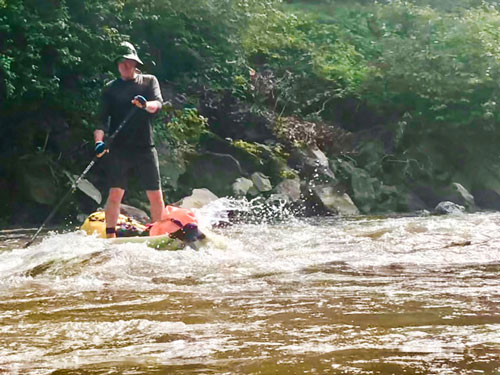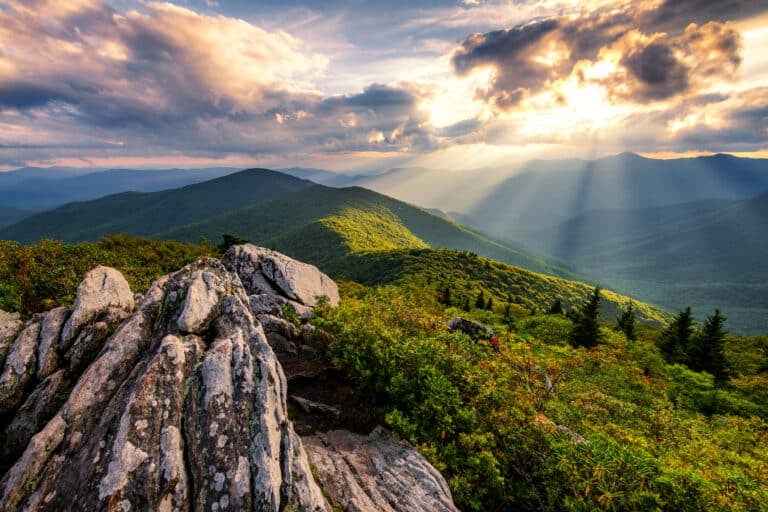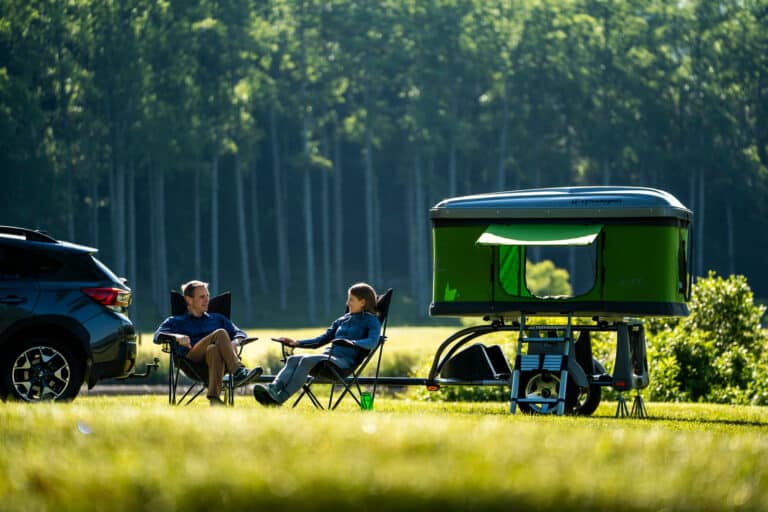Click here to read Day 3
Part 2: The Tailwaters

A Cherokee Legend:
Uktena was a serpent as large around as a tree trunk, with antlers on its head, a blazing crest on its forehead and scales glowing like fire living in the river. Whoever is seen by Uktena is so dazed by the bright light he runs toward the snake instead of trying to escape. There is a location 2 miles above Deep Creek near Bryson City where Uktena struggled and left deep scratches while trying to move upriver.
June 26, 2018, day 4/7
Have you ever slept below a dam? My first experience was below the Fontana Dam. All night there was a pulsing green glow and hum, a UFO-like reminder that I was not at home in my bed. John Sherman and I awoke below the Cedar Cliff Lake to the eerie sound of a dam spewing water out of a concrete hole and a huge generator spinning electricity. John emerged out of his green hammock-tent like a molting stonefly. Blank and expressionless he muttered “I hate being wet”. We awoke to mud, mist and river. The crack of lightning and the tsunami rain from the portage last night jarred and drenched our spirits into a sleepless night. We started a fire.
The last three days were brutal, orienteering with paddleboards down one of the most dramatic river basins in the world. The hidden grandeur of the Tuckasegee River is the headwaters of the East Fork. We paid a price. Sore and fatigued, wet and discouraged by rain, John now with a swollen finger; I was beginning to question the wisdom of our trip. We are both “solo adventurers”, self-proclaimed tough guys that prefer going it alone. We quietly ate our breakfast, John prefering to cook non-Mountain House freeze dried breakfast on his own cook stove. I looked irritably back and forth between Johns fluorescent tent hanging 3 feet off the mud and my brown tarp slung over my paddleboard sitting directly in it.
Still on the East Fork of the Tuckasegee we were now below the last dam-controlled section. Finally, I told John, we will be paddling on a conventional river trip rather than traversing bone-crunching drops, portages and man-made lakes. We stuffed wet gear into waterproof bags and secured it on our paddleboards. The next 2 miles were class 1-2 whitewater down to the little town of Tuckasegee where the West Fork joins. The Tuckasegee River now flows unrestricted 60 miles to the Little Tennessee River at Lake Fontana.
The Cherokee and other Native Americans have a long history with the Tuckasegee river. The name Tuckasegee has various origins…..a popular consensus is an anglicization of the word Tsiksitsi meaning “crawling terrapin” due to the rivers sluggish waters. Evidence of fishing weirs (V-shaped rock funnels) are still evident. The first one encountered was just before the Shook Cove public access area. The water is shallow and slid over pebbles and sand sluicing us downstream into the apex of the weir. Our Badfish paddleboards are designed for fishing allowing for heavy gear and fishing poles to be secured and still navigate rapids. We pulled into an eddy to photograph and fish. Soon the sun broke out, drying us and reviving our spirits.
After traversing the wide Yosemite-like origins of the East Fork it is easy to understand the physics of flooding; a broad granite escarpment as far as the eye can see acting like a stone plate funnelling rain water to a river as wide as a two-lane country road. This river has had its share of tragedies. On December 30, 1882 the ‘most awful’ public works of the state occurred. Nineteen convicts, part of a chain gang, drowned while crossing the river. They were buried in a mass grave with no marker to honor the site, though it is believed to be near the Cowee Tunnel. Even today the tunnel’s ceiling continues to drip, some say it’s the tears of the convicts. In 1840 there was a record high ‘May Fresh’ flood which occurred as settlers were beginning to arrive. In 1940 “the great deluge” occurred. Houses, barns, animals and people were swept away including every bridge that crossed the river. Towns and families were left isolated, leaving some to send messages across the river with bows and arrows. The dams were built soon after providing a level of protection to downstream communities as well as electricity and controlled releases for boaters and fisherman.
Moving much quicker now we made good time to East Laporte River Park in Cullowhee and stopped to dry out our gear. Wet sleeping bags, clothes and food were laid it out in the sun to dry. I took John through the experience of gutting and filleting his first trout with a ceremonial flare. The tasty fish was washed down with a local IPA from the gas station across the street.
John noticed a leak in his paddleboard and his attempt to repair it was unsuccessful. I called my wife Jana who kindly drove from Asheville to pick up John and his useless paddleboard. While home, he noticed his left ring finger was turning blue from his injury hiking Bonas Defeat. He went to the emergency room and had his ring cut off saving his finger. While all this drama played out I paddled downstream a few miles into Cullowhee, near the Western Carolina University and camped on a sandbar in the middle of the river. My “solo” night included a bonfire on the beach, late night swim and fresh trout for breakfast.








